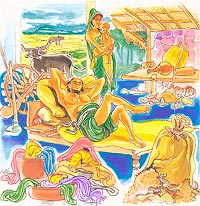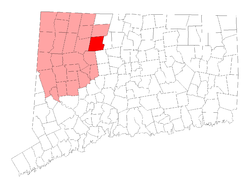Dhammapada Verse 241 Laludayi Vatthu-Causes Of Stain
AWAKEN ONE WITH AWARENESS ONLINE GOOD NEWS LETTER
ALL ABOUT USA
Connecticut

Verse 241. Causes Of Stain
For oral tradition, non-recitation,
in household life, non-exertion,
the fair of form when slovenly,
a sentry’s sloth: all blemishes.
Explanation: For formulas that have to be memorized, non repetition
is the rust. For houses the neglect of the inmates is the rust. For
complexion non-caring is the rust. For a guard heedlessness is the
rust.
Dhammapada Verse 241
Laludayi Vatthu
Asajjhayamala manta
anutthanamala ghara
malam vanaassa kosajjam
pamado rakkhato malam.
Verse 241: Non-recitation is the taint of learning; non-maintenance is the
taint of houses; indolence is the taint of beauty; unmindfulness is the taint of
one who keeps watch.
The Story of Laludayi
While residing at the Jetavana monastery, the Buddha uttered Verse (241) of
this book, with reference to Thera Laludayi.
In Savatthi, people coming back after hearing the discourses given by Thera
Sariputta and Thera Maha Moggallana were always full of praise for the two Chief
Disciples. On one occasion, Laludayi, hearing their praises, said to those
people that they would be saying the same about him after listening to his
discourses. So Laludayi was asked to deliver a discourse; he climbed on to the
platform but he could not say anything. So he asked the audience to let another
bhikkhu take the turn first and that he would take the next turn. In this way,
he put off three times.
The audience lost patience with him and shouted, “You big fool! When we
praised the two Chief Disciples you were vainly boasting that you could preach
like them. Why don’t you preach now ?” So Laludayi ran away and the crowd
chased him. As he was frightened and was not looking where he was going, he fell
into a latrine pit.
When the Buddha was told about this incident, he said, “Laludayi had
learned very little of the Dhamma; he does not recite the religious texts
regularly; he has not memorized anything. Whatever little he has learned gets
rusty by not reciting.”
Then the Buddha spoke in verse as follows:
| Verse 241: Non-recitation is the taint of learning; non-maintenance is the taint of houses; indolence is the taint of beauty; unmindfulness is the taint of one who keeps watch. ALL ABOUT USA Connecticut http://www.bffct.net/id23.html
|
|||||||||||||||
| The colors of Buddha’s enlightenment |
 |
| The official Buddhist Flag |
Taking the Bodhisattva Vows
The
Bodhisattva Vows are the
very essence of the Mahayana
(Universal Vehicle) Buddhism. They are the torch lighting our spiritual
path. These Vows are
the great boat that carries us all
to the Other Shore, the Pure Land,
and the inspiration guiding us in
this life with the great heart of compassion and love. A Bodhisattva is a
being that devotes
him or herself to compassionate
deeds, striving to benefit all beings and seeking their Enlightenment
before his or her own.
By
taking refuge in the Bodhisattva
Vows, we endow our lives with
profound spiritual meaning. They allow us to embody our highest
religious aspirations, in which
we commit ourselves to deeper
understanding and love and selfless service. They have the power to
transform us into gentle
spiritual warriors with courageous
armor of patience, perseverance and mindfulness, and enduring arrows of
generosity, wisdom
and compassion.
These
Vows are a living promise
that we reaffirm everyday, not just
once in a lifetime. Therefore, we should strive to recite them regularly
and practice
them always.
Sentient Beings are numberless,
I vow to save them all.
Sufferings
are inexhaustible,I
vow to end them all.
Dharmas are boundless,
I vow to learn them all.
The
Buddha Way is unsurpassable,I
vow to embody it.
Taking the Five Precepts
The Fivefold
Precepts
have the capacity to protect life
and make our lives beautiful. They are not rules or commandments but are
guidelines to wholesome
and ethical living and truly witness
our commitment to live an awakened life. Throughthe compassionate working of Amida
in our lives, we are empowered to better practice them and are
encouraged to move forward
in the direction of peace, joy and
awakening. Likewise, they are the foundation for the happiness of the
individual, family
and society. These Precepts help us
avoid making mistakes and creating suffering, fear and despair but
instead bring joy,
understanding and peace into our
suffering world.
The Five Precepts are
as follows:
1. I practice the training of love, I refrain from killing.
2. I practice the training of generosity, I refrain from stealing.
3. I practice the training of contentment, I refrain from sexual misconduct.
4. I practice the training of mindful speech, I refrain from harmful
speech.
5.
I practice the training of mindful consumption; I refrain from intoxicants& harmful substances that harm myself, society
and the environment.
A Path for All
We
are talking about going
on a wonderful path and living a new
kind of lifestyle. For 2,500 years, Buddhism has been a proven path for
millions of practitioners.
It may be now up to you to travel it
too. You must understand this is completely possible; there is no
reason at all that
you cannot travel this path. This is the beauty of the Pure Land
teachings: it is completely available
to all whether we are saints or
sinners, ignorant or wise. Remember Great Compassion always remain with
us. She is moving,
seeking and working to liberate you
from suffering. Just stop, take notice and be grateful.
![]()
![]()
![]()
|
“Emancipation is promised
even while we are in Samsara.”
–Zuiken |
• Do Ngak Kunphen Ling Tibetan Buddhist Center for Universal Peace, Redding, Connecticut
http://en.wikipedia.org/wiki/Do_Ngak_Kunphen_Ling_Tibetan_Buddhist_Center_for_Universal_Peace
Do Ngak Kunphen Ling Tibetan Buddhist Center for Universal Peace
Do Ngak Kunphen Ling Tibetan Buddhist Center for Universal Peace
(མདོ་སྔགས་ཀུན་ཕན་གླིང་།) (DNKL) is a Tibetan Buddhist retreat center located in Redding, Connecticut. It offers classes and meditation retreats in the Gelug spiritual tradition of His Holiness the 14th Dalai Lama under the guidance of Gyumed Khensur Rinpoche Lobsang Jampa.
• New Haven Zen Center, New Haven, Connecticut
“New Haven” redirects here. For other uses, see New Haven (disambiguation).
New Haven is the second-largest city in Connecticut and the sixth-largest in New England. With a population of 129,779 people,[1] New Haven is the principal municipality in the Greater New Haven metropolitan area, which had a total population of 571,310 in 2000.[2][3] It is located in New Haven County, on New Haven Harbor, on the northern shore of Long Island Sound.
New Haven was founded in 1638 by English puritans, and a year later eight streets were laid out in a four-by-four grid, creating what is now commonly known as the “Nine Square Plan”,[4] now recognized by the American Institute of Certified Planners as a National Historic Planning Landmark. The central common block is New Haven Green, a 16-acre (6 ha) square, now a National Historic Landmark and the center of Downtown New Haven.
New Haven is the home of the Ivy League school Yale University. The university is an integral part of the city’s economy, being New Haven’s biggest taxpayer and employer,[5] as noted in the Mayor’s 2010 State of the City address.[6]
Health care (hospitals and biotechnology), professional services
(legal, architectural, marketing, and engineering), financial services,
and retail trade also help to form an economic base for the city.
New Haven had the first public tree planting program in America, producing a canopy of mature trees (including some large elms) that gave New Haven the nickname “The Elm City”.[7]
| City of New Haven | |||
|---|---|---|---|
| — City — | |||
|
Skyline of Downtown New Haven |
|||
|
|||
| Nickname(s): The Elm City | |||
|
Location in New Haven County, Connecticut |
|||
| Coordinates: 41°18′36″N 72°55′25″WCoordinates: 41°18′36″N 72°55′25″W | |||
| Country | United States | ||
| State | Connecticut | ||
| NECTA | New Haven | ||
| Region | South Central Region | ||
| Settled | 1638 | ||
| Incorporated (city) | 1784 | ||
| Consolidated | 2010 | ||
| Government | |||
| • Type | Mayor-board of aldermen | ||
| • Mayor | John DeStefano, Jr. (D) | ||
| Area | |||
| • City | 20.31 sq mi (52.6 km2) | ||
| • Land | 18.9 sq mi (49.0 km2) | ||
| • Water | 1.4 sq mi (3.6 km2) | ||
| • Urban | 285.3 sq mi (738.9 km2) | ||
| Elevation | 59 ft (18 m) | ||
| Population (2010)[1] | |||
| • City | 129,779 | ||
| • Density | 6,860/sq mi (2,648.6/km2) | ||
| • Urban | 569,000 | ||
| • Metro | 846,766 | ||
| • Demonym | New Havener | ||
| Metro area refers to New Haven County | |||
| Time zone | Eastern (UTC-5) | ||
| • Summer (DST) | Eastern (UTC-4) | ||
| ZIP code | 06501-06540 | ||
| Area code(s) | 203 | ||
| FIPS code | 09-52000 | ||
| GNIS feature ID | 0209231 |
||
| Airport | Tweed-New Haven Regional Airport (New Haven, CT) – HVN (County) | ||
| Website | www.cityofnewhaven.com | ||
• Dae Yen Sa, New Hartford, Connecticut
mp to: navigation,
search
| New Hartford, Connecticut | |||
|---|---|---|---|
| — Town — | |||
|
“Central Avenue, New Hartford,” a 1910 postcard |
|||
|
|||
|
Location in Litchfield County, Connecticut |
|||
| Coordinates: 41°50′29″N 73°00′15″WCoordinates: 41°50′29″N 73°00′15″W | |||
| Country | United States | ||
| State | Connecticut | ||
| NECTA | Hartford | ||
| Region | Litchfield Hills | ||
| Incorporated | 1738 | ||
| Government | |||
| • Type | Selectman-town meeting | ||
| • First selectman | Daniel V. Jerram | ||
| Area | |||
| • Total | 38.1 sq mi (98.7 km2) | ||
| • Land | 37.0 sq mi (95.9 km2) | ||
| • Water | 1.1 sq mi (2.9 km2) | ||
| Elevation | 873 ft (266 m) | ||
| Population (2005)[1] | |||
| • Total | 6,746 | ||
| • Density | 182/sq mi (70/km2) | ||
| Time zone | Eastern (UTC-5) | ||
| • Summer (DST) | Eastern (UTC-4) | ||
| ZIP code | 06057 | ||
| Area code(s) | 860 | ||
| FIPS code | 09-51350 | ||
| GNIS feature ID | 0213470 | ||
| Website | www.town.new-hartford.ct.us | ||
New Hartford is a town in Litchfield County, Connecticut, United States. The population was 6,088 at the 2000 census. The town center is also defined by the U.S. Census Bureau as a census-designated place
(CDP). The town is mainly a rural community consisting of farms, homes,
and parks. Brodie Park and Ski Sundown are located in New Hartford.




























